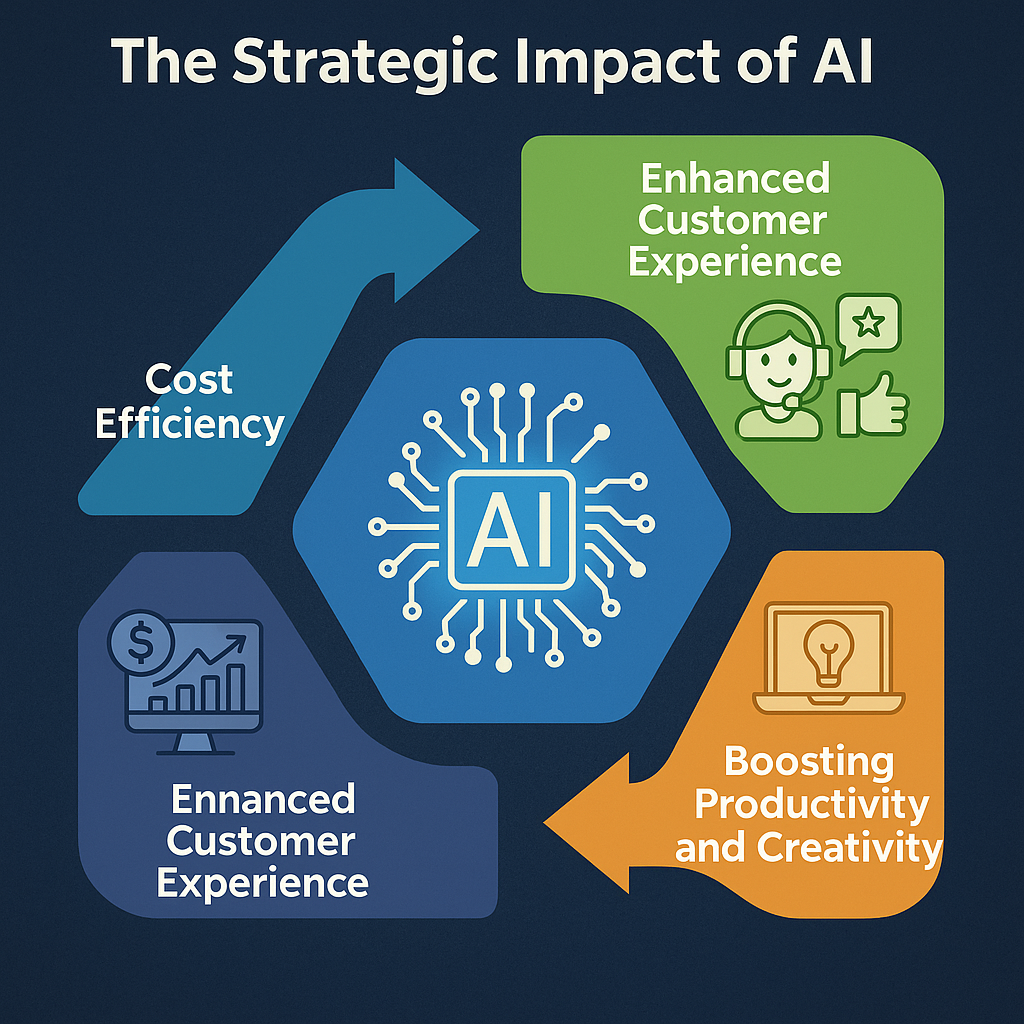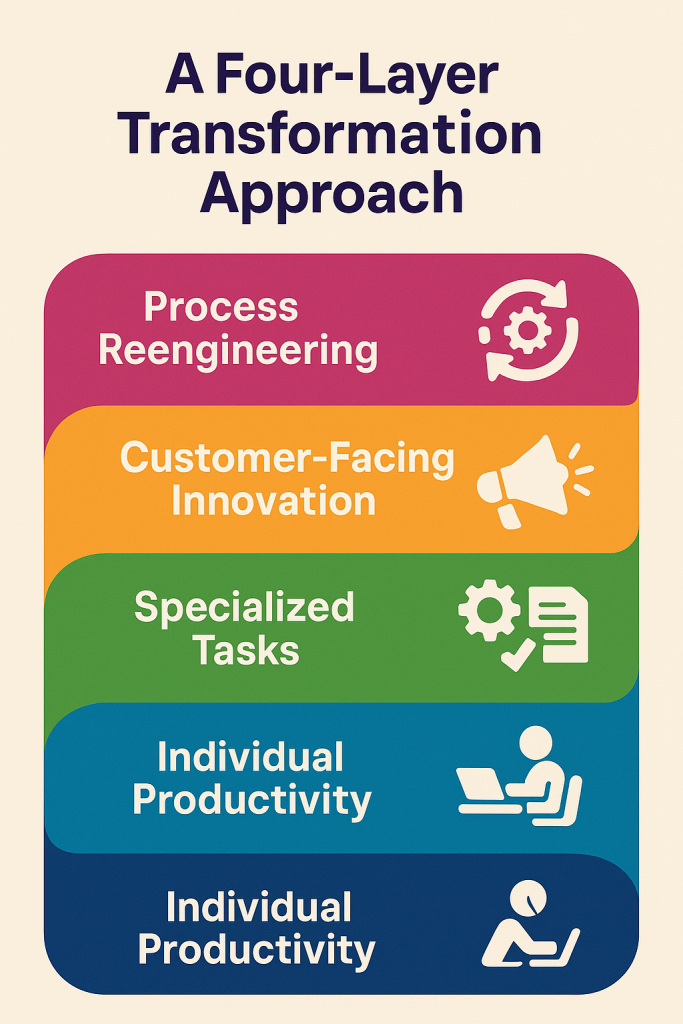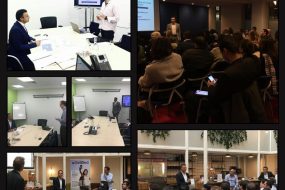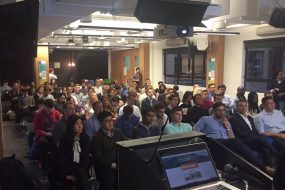
Strategic Integration of Generative AI: A Practical Playbook for Business Transformation
Farhad Reyazat -PhD in Risk Management
Citation: Reyazat, F. (2025e, July 28). Strategic Integration of Generative AI: A Practical Playbook for Business Transformation. London Institute of Banking and Finance. https://www.reyazat.com/2025/07/28/strategic-integration-of-generative-ai-a-practical-playbook-for-business-transformation/
Introduction
The rise of generative AI marks a turning point in how businesses compete, operate, and grow. Once considered a niche technical innovation, it has now become a strategic tool capable of reshaping business models, accelerating productivity, and unlocking new forms of value creation. From automated content generation to hyper-personalized customer engagement and intelligent decision support, generative AI is already transforming core business functions across industries.
But while the technology is advancing at breakneck speed, most organizations still face a far greater challenge: adapting their structures, processes, and leadership capabilities to use it effectively. The real competitive advantage lies not in the AI model itself, but in how well an organization integrates it into everyday workflows, aligns it with business priorities, and builds a culture capable of learning and evolving alongside it.
This article provides a comprehensive and practical guide for business leaders and strategists seeking to integrate generative AI into their operations and long-term strategies. It begins by demystifying the core types of AI and their business relevance, then explores high-impact use cases across operations, customer experience, and business model innovation. It introduces a structured framework for integrating AI, covering governance, risk management, and cultural readiness. Ultimately, it outlines a pathway from small-scale adoption to organization-wide transformation, enabling leaders to transition from experimentation to a sustained strategic advantage.
Demystifying AI: What Business Leaders Need to Know
Before integrating generative AI into your business model, it’s essential to understand how it fits into the broader landscape of artificial intelligence. While the term “AI” is often used broadly, it encompasses a range of technologies with different capabilities and implications for business use.
At the foundation are rule-based systems, also known as expert systems, which rely on predefined logic and decision trees. These work well in structured environments with clear rules, such as compliance checks or prescription workflows. Next are statistical models, often used in econometrics. These systems analyze structured numerical data to identify correlations, trends, and probabilities. They are common in forecasting, credit scoring, and operational optimization.
The third tier is deep learning, which uses neural networks to process large volumes of unstructured data. Deep learning powers image recognition, speech-to-text, and complex behavioral predictions. And finally, generative AI—the latest evolution—doesn’t just classify data, it creates new content by predicting patterns in language, code, images, and more. Its strength lies in handling ambiguity, generating drafts, and augmenting creativity at scale.
Understanding these distinctions is crucial because each type of AI is well-suited to different kinds of business problems. Importantly, AI is not truly intelligent. It lacks context, intent, and judgment. Human oversight remains crucial to ensure relevance, accuracy, and the ethical application of these principles.
As one researcher aptly put it, “Technology changes fast. Organizations change much more slowly.” Successful AI integration isn’t just about tools—it’s about transforming mindsets, systems, and leadership to keep pace with opportunity. The following section outlines the steps to accomplish this.
The Role of Generative AI in Business Strategy
To unlock the full value of generative AI, business leaders must shift their focus away from the technology itself and begin with a much more important question: What problem are we solving? The most successful AI-driven strategies are not those that start with the flashiest tools, but those rooted in precise business needs—whether that’s improving margins, serving customers better, or accelerating innovation.
Generative AI is uniquely positioned to support these goals. At its core, it is a powerful enabler of scale, speed, and creativity—capable of generating content, summarizing information, supporting decision-making, and engaging customers in ways that were previously costly or impossible. It is already acting as a catalyst across four central strategic pillars:
- Cost Efficiency: AI-driven automation can significantly reduce labor-intensive tasks. Research shows that companies integrating generative AI into functions such as finance, HR, and marketing report operational cost reductions of 15–25%. Drafting proposals, generating reports, or building software is now faster and more cost-effective.
- Enhanced Customer Experience: Generative AI enables real-time personalization at scale. Companies are using AI to power conversational assistants, tailor marketing campaigns, and even create personalized product designs—turning generic interactions into meaningful relationships.
- Business Model Evolution: Generative AI opens the door to entirely new offerings—such as AI-generated content subscriptions, automated consulting, or dynamic pricing systems. It enables companies to transition from selling products to offering data-driven services.
- Boosting Productivity and Creativity: Employees benefit from reduced cognitive load and faster access to insights. Whether it’s marketers drafting campaign copy, analysts summarizing reports, or developers writing code, AI acts as a thought partner—enhancing human performance, not replacing it.
- Strategically, generative AI creates leverage in four key areas: personalized engagement, automation of knowledge work, augmented decision-making, and scalable innovation. In the next section, we’ll explore real-world use cases that demonstrate how organizations are implementing this approach.

Practical Use Cases: Generative AI in Action
While the hype around generative AI is immense, its real value emerges when embedded into specific workflows that solve real business problems. From streamlining operations to reshaping customer journeys and enabling new business models, leading organizations are already leveraging generative AI—with measurable results.
Transforming Internal Operations and Efficiency
One of the most immediate and widespread applications of generative AI lies in internal operations. In software development, tools like GitHub Copilot and Amazon CodeWhisperer are enabling developers to write code faster, reduce bugs, and auto-generate documentation. A recent study found that developers using AI coding assistants completed tasks up to 56% faster, resulting in a significant increase in delivery velocity.
In HR, large language models are automating tasks such as job descriptions, interview question generation, onboarding material creation, and even predictive talent analytics. Research from EY shows that companies utilizing AI in HR have improved productivity by up to 30%, while enhancing the candidate experience and reducing bias in the screening process.
Finance departments are also benefiting. From auto-generating financial reports to analyzing large data sets for anomalies or trends, generative AI reduces the time spent on repetitive analysis. Goldman Sachs recently deployed internal generative tools across departments, reporting measurable gains in efficiency and accuracy.
Enhancing Customer Experience
Customer service has seen a dramatic shift with the adoption of AI-powered assistants. Cresta’s real-time coaching platform, for example, listens to live calls and provides on-the-spot suggestions, helping agents manage tone, explain products more effectively, and close sales more quickly. Companies using this approach report up to 30% improvement in call center efficiency.
Retailers such as Coach and Kate Spade are utilizing generative tools to create highly personalized marketing campaigns and product recommendations at scale. Paired with multilingual content generation, brands can now localize their messaging globally with unprecedented speed and cost efficiency.
Enabling Business Model Innovation
Generative AI isn’t just improving existing models—it’s enabling new ones. Companies are shifting from selling static products to offering AI-driven services. For instance, generative AI allows firms to monetize their internal knowledge (e.g., McKinsey’s internal LLM, which retrieves past insights from thousands of consulting decks) and offer tiered content or data-as-a-service subscriptions.
Accelerating Learning and Upskilling
In education and corporate training, AI tutors are revolutionizing how people learn. MIT’s Media Lab, for example, is developing intelligent tutors that offer personalized support to underrepresented students in coding courses, helping to close achievement gaps. Meanwhile, creative agencies like Dentsu are fostering internal adoption through AI “office hours,” where employees share prompts and discoveries—building a culture of collective innovation.
In all these cases, generative AI acts not as a replacement for human talent, but as a multiplier of it. It enhances speed, accuracy, personalization, and creativity—freeing employees to focus on strategic, value-creating work. In the next section, we’ll explore how to build the infrastructure, governance, and leadership capacity required to scale these innovations enterprise-wide.
Embedding Generative AI Strategically: A Practical Implementation Framework
Adopting generative AI is not a matter of simply plugging in a new tool—it requires deliberate, staged transformation aligned with business priorities, operational maturity, and organizational readiness. To avoid the common pitfalls of fragmented pilots or unmanaged risk, leaders must adopt a layered, strategic implementation framework.
A Four-Layer Transformation Approach
The most successful organizations deploy generative AI in progressive layers:
- Individual Productivity
Start by enabling employees with AI-powered assistants—tools that draft emails, summarize documents, generate content, or assist with code. These low-risk use cases build familiarity and quick wins. - Specialized Tasks
Next, embed AI into functional roles. HR teams can automate resume screening and training content; finance can streamline reporting and analytics; marketing can auto-generate campaign content. These targeted deployments often deliver rapid ROI. - Customer-Facing Innovation
With confidence and capabilities in place, extend AI to customer touchpoints—such as AI chatbots, multilingual content delivery, and personalized shopping assistants —to enhance the customer experience. These applications directly enhance engagement and scale customer experience. - Process Reengineering
Finally, reimagine end-to-end workflows using AI as a core engine. Examples include automated underwriting, smart contract generation, or supply chain optimization—complex transformations that require robust governance and cross-functional integration.

Prioritization, Infrastructure, and Governance
Every use case should be evaluated based on its potential value and associated risks. Begin with low-risk, high-value opportunities and build momentum. Underpinning this effort must be a stable foundation: clean, accessible data; secure, scalable infrastructure; and clear governance frameworks.
Despite the hype, only 4% of organizations are fully prepared to support GenAI at scale. Many struggle with siloed data, outdated systems, and a lack of ethical oversight. Building AI fluency across departments and investing in a semantic data layer are crucial steps toward readiness.
Balancing Autonomy and Oversight
Generative AI introduces new challenges—chief among them: explainability. Outputs are often difficult to trace or validate. To mitigate this, organizations should embed human-in-the-loop (HITL) protocols where necessary, such as for approvals, supervision, or quality control. Not every AI decision must be fully explainable—but every decision should be accountable.
Establishing an internal AI governance council can help ensure the safe deployment of AI. This body, comprising leadership, IT, legal, and business users, sets usage policies, monitors performance, and enforces ethical boundaries. Meanwhile, internal “AI champions” can drive adoption, share prompting techniques, and close capability gaps across teams.
From Pilots to Platforms
A successful GenAI rollout isn’t a one-time initiative—it’s an evolving capability. By layering transformation, ensuring infrastructure readiness, embedding safeguards, and continuously measuring business outcomes, organizations can turn generative AI from a trend into a strategic advantage.
Governance, Risk, and Ethics: Making Generative AI Safe, Responsible, and Trusted
As generative AI transitions from experimentation to enterprise-wide deployment, the challenge is no longer whether to use the technology, but how to use it responsibly. To ensure generative AI delivers long-term value without compromising integrity, organizations must adopt thoughtful governance structures, robust risk management protocols, and clear ethical standards.
Balancing Control and Innovation
One of the first decisions organizations face is whether to centralize or decentralize AI innovation. A top-down approach, such as the one used by Société Générale, involves establishing centralized infrastructure, reviewing use cases for compliance and risk, and rolling out solutions in a controlled and systematic manner. This model offers safety, consistency, and efficiency—especially for highly regulated industries.
On the other hand, decentralized models, such as Cisco’s, allow individual teams to innovate rapidly within a defined ethical framework. Business units can identify their use cases while adhering to overarching principles around fairness, transparency, and accountability. For many companies, a hybrid approach—central oversight with local experimentation—strikes the right balance.
Understanding and Managing AI Risks
Generative AI introduces unique risks. Hallucinations, where the AI fabricates information, can erode trust. Data bias can reinforce systemic inequities if not adequately addressed. And legal exposure—from privacy violations to intellectual property misuse—remains a serious concern. Mitigating these risks requires embedding AI guardrails: clear use policies, rigorous model testing, human oversight, and data governance practices that prioritize quality and compliance.
Ethics by Design
Responsible AI isn’t an afterthought—it must be embedded from the start. Organizations should establish ethical review boards, implement effective feedback mechanisms, and establish transparent escalation procedures for incidents. Continuous monitoring, bias audits, and model explainability assessments are critical to ensure systems behave as intended.
Earning Stakeholder Trust
Trust is the foundation of AI adoption. Internally, employees must understand how AI impacts their roles and how ethical safeguards protect their input and agency. Externally, customers expect transparency—clarity on how AI is used, how decisions are made, and where humans remain in control. Companies that communicate their AI principles and offer human fallback options are better positioned to build lasting trust.
Culture & Capability: Empowering People in an AI-First World
Generative AI is most effective not when it replaces people, but when it enhances them. The real value lies in designing AI as a force multiplier that automates routine tasks and amplifies strategic thinking, freeing employees to focus on creativity, collaboration, and impact.
AI as Augmentation, Not Replacement
The most forward-thinking companies position AI as a partner—not a threat. For example, marketing teams utilize generative tools to draft proposals, freeing creative professionals to refine and enhance their outputs rather than starting from scratch. This approach drives efficiency while preserving—and often improving—quality.
Re-skilling & Internal Knowledge Sharing
Reskilling remains critical. Leading organizations dedicate resources to training, peer-led workshops, and prompt-sharing sessions. One standout example is Dentsu, where teams host “office hours” for employees to share their best prompts and discoveries with generative AI. These internal forums accelerate adoption and foster cross-team collaboration.
Psychological Safety & Innovation Mindset
Embedding AI requires a mindset shift across the organization. Employees must feel safe exploring new tools—even when they fail. Encouraging experimentation, rapid iteration, and learning from mistakes creates an environment where AI fuels innovation rather than resistance. Psychological safety is foundational for this shift.
Human Skills Are Still Critical
Technical adoption is only one part of the equation. As business transformations evolve, soft skills remain vital. MIT’s framework for human skills emphasizes four core areas: critical thinking, collaboration, adaptability, and leadership. These skills enable humans to effectively partner with AI — evaluating outputs, navigating ambiguity, and guiding innovation responsibly.
A 2025 analysis underscores that the most successful AI-driven organizations are those led by people fluent in the “4Cs of AI fluency” — creativity, critical thinking, communication, and cultural agility. It’s employees with these skills who turn GenAI into a competitive advantage.
By focusing on augmentation over automation, investing in reskilling, fostering a safe learning environment, and valuing human skills, organizations position themselves for sustainable AI adoption that benefits both the company and its people.
Conclusion: Small ‘t’ Transformations Leading to Big ‘T’ Disruption
Generative AI is not a silver bullet—but it is a potent tool when used strategically. Its actual value emerges not from sweeping overhauls, but from a series of small, intentional changes that accumulate into transformative impact. These ‘small ‘t’ transformations—such as automating reports and personalizing customer interactions—create the operational learning and cultural momentum required for larger, systemic change.
Successful organizations don’t wait for perfect conditions. They begin with focused pilots, prioritize use cases by value and risk, and create fast feedback loops to refine their approach. This mindset—start small, learn fast, and scale wisely—enables continuous adaptation in a rapidly evolving landscape.
At the same time, leadership must provide clear guardrails, including ethical frameworks, human oversight, and transparency, that foster both innovation and accountability. It’s through this balance—of creativity and control, automation and augmentation—that generative AI delivers its highest returns.
Now is the time to act. Equip your teams, empower experimentation, and build the infrastructure for scale. Generative AI may not replace strategy, but it will increasingly define how strategy is executed. Start with today’s opportunities—and position your organization for tomorrow’s disruption.
Refrences
McKinsey & Company. (2023). How AI is transforming strategy development. Retrieved from https://www.mckinsey.com/capabilities/strategy-and-corporate-finance/our-insights/how-ai-is-transforming-strategy-development
EY. (2023). Generative AI in Action: Use Cases Across Industries. Retrieved from https://www.ey.com/content/dam/ey-unified-site/ey-com/en-us/alliances/documents/ey-use-cases.pdf
Venture Magazine. (2023). Demystifying AI: What Every Business Leader Needs to Know to Stay Ahead. Retrieved from https://blog.venturemagazine.net/demystifying-ai-what-every-business-leader-needs-to-know-to-stay-ahead-9e25652d776e
ResearchGate. (2024). Chatterjee, A., & Sinha, R. Generative AI in Strategic Business Planning: Boosting Efficiency and Competitive Advantage in Business Organizations. Retrieved from https://www.researchgate.net/publication/389441384
ResearchGate. (2023). AI in Decision Making: Transforming Business Strategies. Retrieved from https://www.researchgate.net/publication/377345979
AlignMinds. (2024). How to Develop a Roadmap for GenAI Implementation. Retrieved from https://www.alignminds.com/how-to-develop-a-roadmap-for-genai-implementation/
Forbes Technology Council. (2025). How To Smartly And Safely Leverage GenAI In Business. Retrieved from https://www.forbes.com/councils/forbestechcouncil/2025/01/23/how-to-smartly-and-safely-leverage-genai-in-business/
TechTarget. (2024). Generative AI Ethics: 8 Biggest Concerns. Retrieved from https://www.techtarget.com/searchenterpriseai/tip/Generative-AI-ethics-8-biggest-concerns
ResearchGate. (2024). AI and Ethics in Business: A Comprehensive Review of Responsible AI Practices and Corporate Responsibility. Retrieved from https://www.researchgate.net/publication/378548167
3Cloud Solutions. (2023). Cultivating a Culture for AI Integration in the Workplace. Retrieved from https://3cloudsolutions.com/resources/cultivating-a-culture-for-ai-integration-in-the-workplace/
Forbes. Talagala, N. (2025). The 4Cs of AI Fluency: Preparing for the Jobs of the Future. Retrieved from https://www.forbes.com/sites/nishatalagala/2025/07/10/the-4-cs-of-ai-fluency-preparing-for-the-jobs-of-the-future/
McKinsey & Company. (2024). The Organization of the Future: Enabled by GenAI, Driven by People. Retrieved from https://www.mckinsey.com/capabilities/people-and-organizational-performance/our-insights/the-organization-of-the-future-enabled-by-gen-ai-driven-by-people
eBook by B2B Digital Now. (2024). Generative AI in Action. Retrieved from https://b2bdigitalnow.com/wp-content/uploads/1_Generative-AI-in-Action-eBook.pdf
Harvard Business School Executive Education. (n.d.). Competing in the Age of AI. Retrieved from https://www.exed.hbs.edu/competing-age-ai
Reyazat, F. (2024, August 27). How AI can Drive Economic Diversification in Emerging Markets: Unlocking New Opportunities. https://www.reyazat.com/2024/08/27/how-ai-can-drive-economic-diversification-in-emerging-markets-unlocking-new-opportunities/
Reyazat, F. (2024b, July 8). The Rise of AI & Digital Economy: Strategies for Future Leaders in a Revolution More Profound than the Industrial Revolution. Dr. Farhad Reyazat. https://www.reyazat.com/2024/07/08/the-rise-of-ai-digital-economy-strategies-for-future-leaders-in-a-revolution-more-profound-than-the-industrial-revolution/
Reyazat, F. (2024, March 7). Quantum Leap AI: How Gen AI optimizes portfolio structure and investment strategies. London Institute of Banking and Finance. https://www.reyazat.com/2024/03/07/quantum-leap-ai-how-gen-ai-optimizes-portfolio-structure-and-investment-strategies/
More related Topics :






4 replies on “Strategic Integration of Generative AI: A Practical Playbook for Business Transformation”
The Real Person!
Author William acts as a real person and passed all tests against spambots. Anti-Spam by CleanTalk.
Love the concept
The Real Person!
Author Bert acts as a real person and passed all tests against spambots. Anti-Spam by CleanTalk.
How to transform the SMEs ?
The Real Person!
Author Ewa acts as a real person and passed all tests against spambots. Anti-Spam by CleanTalk.
Write more on Systemic Risk
The Real Person!
Author Nichole acts as a real person and passed all tests against spambots. Anti-Spam by CleanTalk.
How can we finance better this transition?